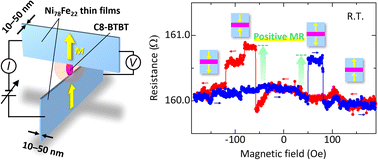Room-temperature magnetoresistance in Ni78Fe22/C8-BTBT/Ni78Fe22 nanojunctions fabricated from magnetic thin-film edges using a novel technique†
Abstract
Molecular spintronic devices are gaining popularity because the organic semiconductors with long spin relaxation times are expected to have long spin diffusion lengths. A typical molecular spintronic device consists of organic molecules sandwiched between two magnetic layers, which exhibits magnetoresistance (MR) effect. Nanosized devices are also expected to have a high spin polarization, leading to a large MR effect owing to effective orbital hybridization. However, most studies on nanosized molecular spintronic devices have investigated the MR effect at low temperatures because of the difficulty in observing the MR effect at room temperature. Here we focus on high-mobility molecules expected to show long spin diffusion lengths, which lead to the observation of the MR effect in nanoscale junctions at room temperature. In this study, we fabricate magnetic nanojunctions consisting of high-mobility molecules, 2,7-dioctyl[1]benzothieno[3,2-b][1]benzothiophene (C8-BTBT), sandwiched between two Ni78Fe22 thin films with crossed edges. Transmission electron microscopy (TEM) images reveal that C8-BTBT molecular layers with smooth and clear interfaces can be deposited on the Ni78Fe22 thin-film edges. Consequently, we observe a clear positive MR effect, that is, RP < RAP, where RP and RAP are the resistances in the parallel (P) and antiparallel (AP) configurations, respectively, of two magnetic electrodes in the Ni78Fe22/C8-BTBT/Ni78Fe22 nanojunctions at room temperature. The obtained results indicate that the spin signal through the C8-BTBT molecules can be successfully observed. The study presented herein provides a novel nanofabrication technique and opens up new opportunities for research in high-mobility molecular nano-spintronics.



 Please wait while we load your content...
Please wait while we load your content...